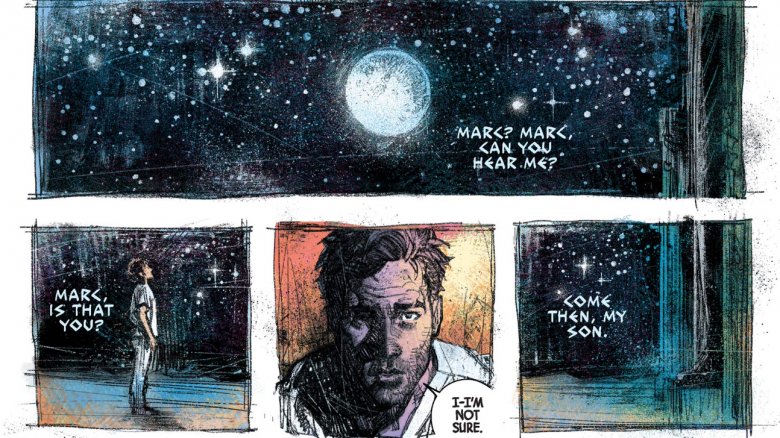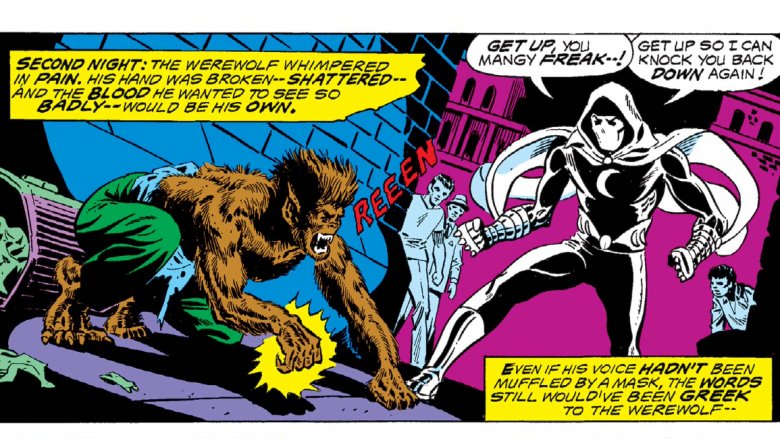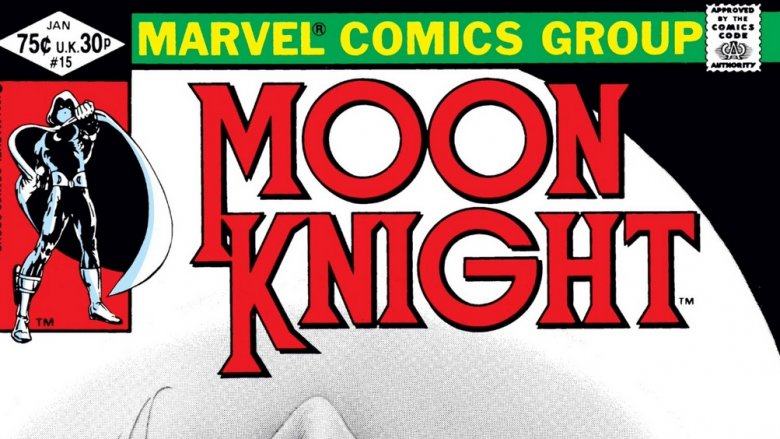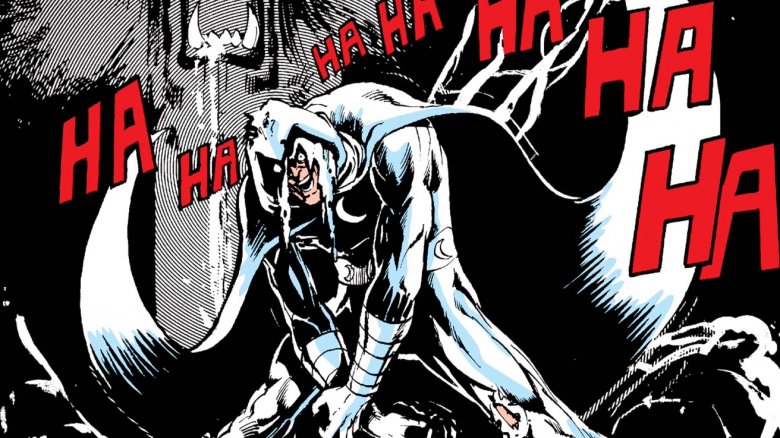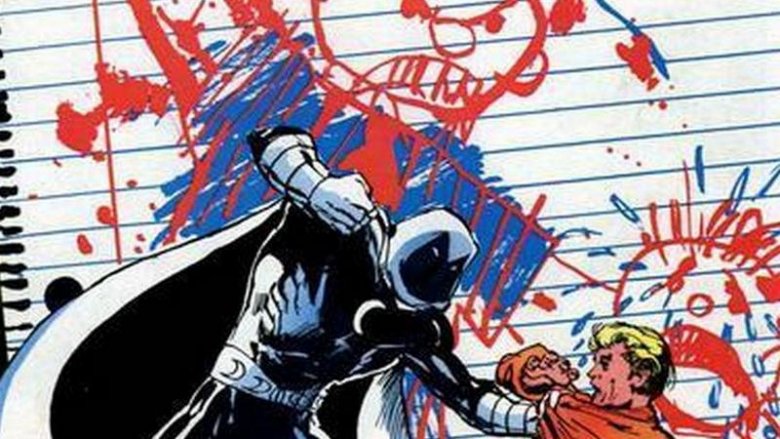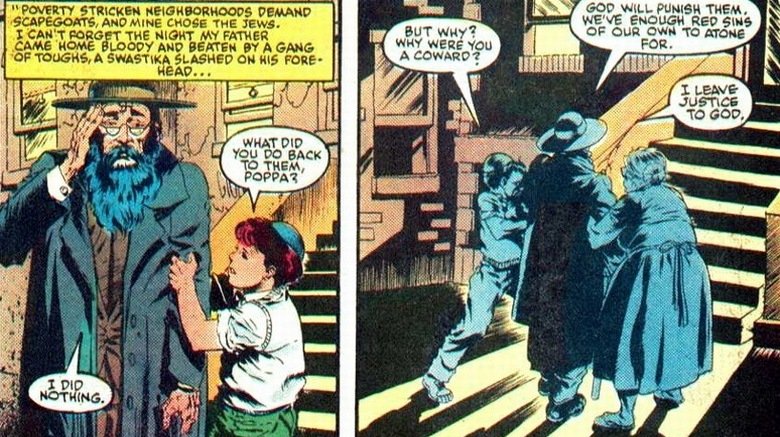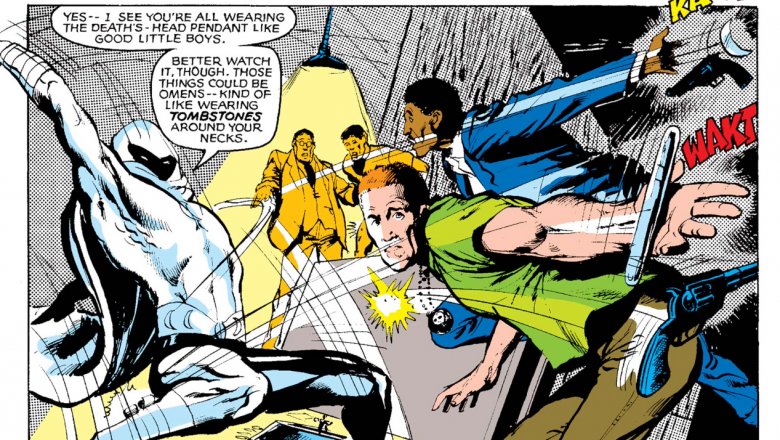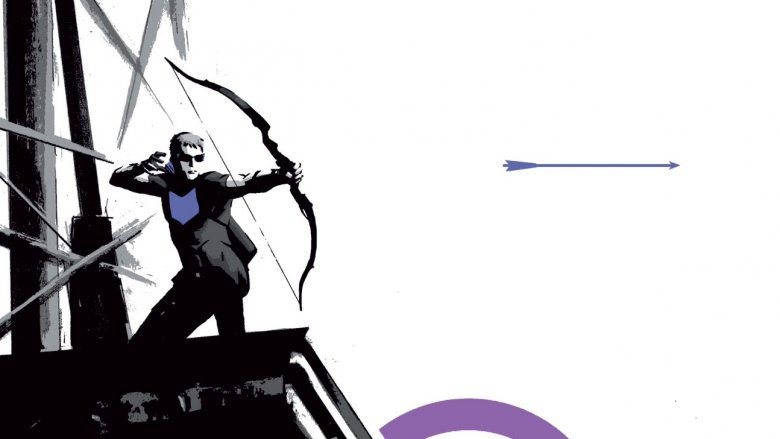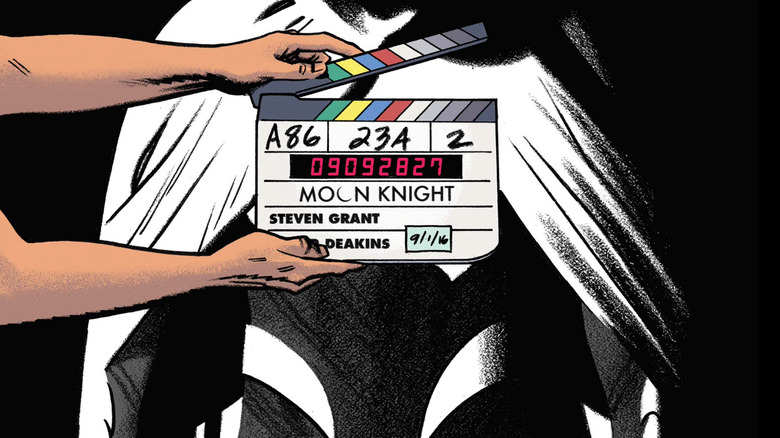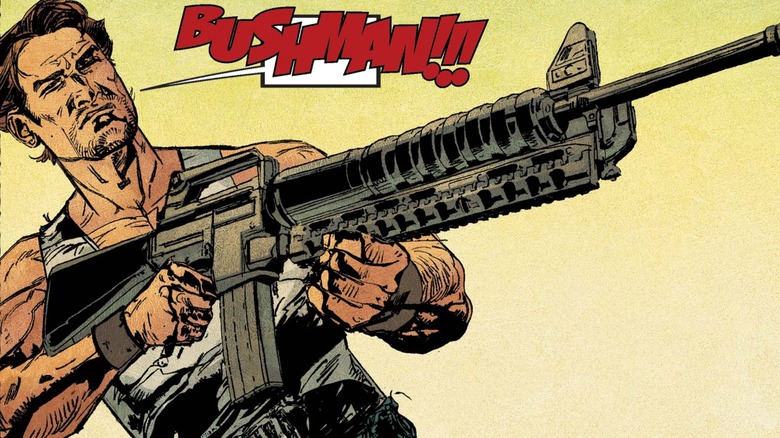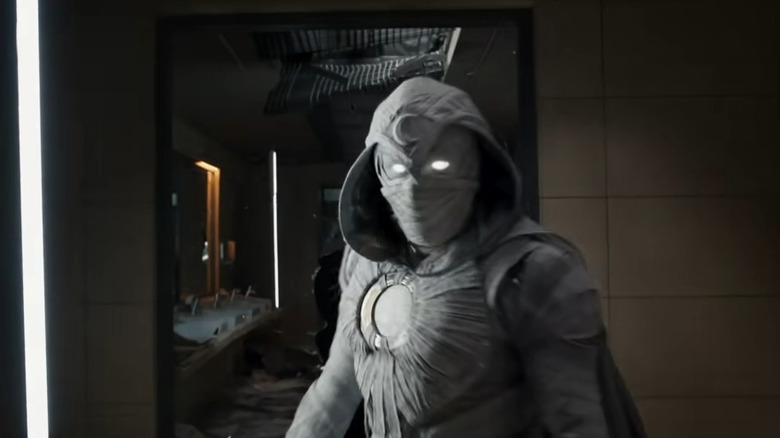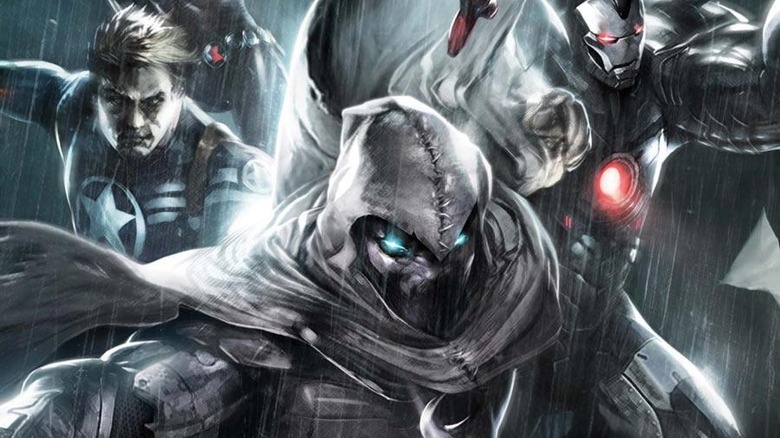Marvel's Moon Knight: The Untold Truth
Depending on who you ask, Marvel's nocturnal hero Moon Knight is either a mercenary, a protector of travelers, an emissary of an ancient Egyptian god, an obvious Batman clone, or just an absolute lunatic. Over the years, the hero's varied portrayals have given readers reason to think of him in any of those ways and more. The character has enjoyed (or endured) countless revivals and reinterpretations, and his relative obscurity gives writers more license to go wild. As Warren Ellis said during the brief but memorable period during which he wrote the character, with Moon Knight, "you can have a play with something knowing that there's not an audience of hundreds of thousands waiting with their knives out."
A side effect of all these revivals and reinterpretations is that the history, the origin, and the very character of Moon Knight have grown muddier. Asking a question as simple as "What's Moon Knight's secret identity?" is complex enough to make you shake your head.
But what hasn't changed is the origin of his creation. The writer and artist who created Moon Knight, as well as the artist who made the first volume of "Moon Knight" the threshold of an artistic career — those facts can't change, no matter how many times Marvel hits the reboot button.
Here's the untold truth of Moon Knight.
Moon Knight's real-life namesake
Moon Knight suffers from Dissociative Identity Disorder, once known as Multiple Personality Disorder. Rather than the usual hero/everyman dichotomy we're used to with Superman and Clark Kent or Spider-Man and Peter Parker, Moon Knight has at least three "civilian" names. There's taxi driver Jake Lockley, millionaire Steven Grant, and finally the mercenary Marc Spector. While he plays at using the personas simply as covers and tools, it's clear even in the very beginning of the earliest volume of Moon Knight that they're much more. The three identities not only speak and act differently, different people in Moon Knight's life choose who they believe is the dominant persona. Moon Knight's love interest Marlene, for example, is in love with Steven Grant and always refers to him as Steven whether he's wearing his mask or not.
But the name co-creator Doug Moench saw as marking Moon Knight's dominant persona was Marc Spector, and Spector's name came from an employee in a Manhattan comic book shop. Moench couldn't remember the name of the store when he told the story, but he did say it was the best comic book shop in Manhattan. At the time, Moench said, he often used the names of people in his life for new characters, and a comic shop employee named Marc Spector asked him "When are you going to name a comic book character after me?" At the time, Moench was working on an issue of "Werewolf by Night" with a villain he needed a name for, and so the real-life Spector got his wish.
Moon Knight's villainous roots
Moench and artist Don Perlin first brought Moon Knight to life in 1975's "Werewolf by Night" #32, and he was no selfless defender of the innocent or avatar of Khonshu. Marc Spector was a mercenary hired by a clandestine group known only as the Committee to capture Jack Russell, the man cursed to transform into a werewolf on nights of the full moon. It was The Committee who gave Spector his name, his costume, and even silver gauntlets and a silver truncheon specifically designed to hurt the savage werewolf.
By the end of "Werewolf by Night" #33, Moon Knight showed at least a hint or two of the hero he would become. While he fulfills his contract by capturing the werewolf and bringing him to the Committee, the accusing pleas of Russell's friends and the desperation of the captive werewolf convince him he's on the wrong side. He frees the werewolf from his cage and helps him escape.
Still, he doesn't exactly come off like Superman. The last time we see him in "Werewolf by Night" #33, Moon Knight is crouched on a roof ledge and triumphantly holding up a fat wad of bills he lifted from the Committee.
An early Direct Sales landmark
To Moench's surprise, Marvel editors not only kept asking him to do more with Moon Knight, but the character he'd created — with nothing more in mind than an antagonist for a werewolf comic — started turning up in guest appearances in "Spectacular Spider-Man," "Defenders," and "Marvel Two-in-One." Moench was tapped for writing duties on the black-and-white "Hulk!" magazine, which eventually included a seven-page backup feature starring Moon Knight.
Ultimately Moench and artist Bill Sienkiewicz — who had jumped aboard during the "Hulk!" backups — were assigned the first monthly "Moon Knight" title. Moench wrote a new, more heroic origin story for the hero, connecting him to Egyptian myth and solidifying Marc Spector as a mercenary seeking redemption.
While the first volume was cut after 38 issues, it enjoyed the honor — along with "Ka-Zar" — of being one of Marvel's first Direct Sales comics. In 1982, more comics were appearing in comic book specialty shops and fewer were being sold in newsstands, grocery stores, pharmacies, gift shops, and toy stores. There was a push to cut out distributors and sell directly to specialty retailers, and "Moon Knight" and "Ka-Zar" were Marvel's flagship titles for that push.
Comic book fans have argued — and will likely continue to argue — whether the move to the direct market was a good one. But in terms of what it meant to Moench and Sienkiewicz in the short term, it meant more royalties because they didn't need to sell as many copies for the comic to turn a profit. It also meant more work, since the comics were printed with only in-house ads and the creative team had to turn in 25 pages of story every issue instead of 19.
Bill Sienkiewicz's breakout
Artist Bill Sienkiewicz, whose unique style is as recognizable as it can be jarring, began his comic book career drawing "Moon Knight."
Sienkiewicz was a second year art student when he brought a portfolio to the offices of DC Comics, but he'd unknowingly picked precisely the wrong time to bark up that particular tree. DC was going through rough times and was about to cut loose many of the artists it already had. Still, Sienkiewicz's talent was evident, so "Batman" artist Neal Adams — whose art Sienkiewicz readily admits he based his own early work on — called Jim Shooter at Marvel Comics and told the controversial Editor-in-Chief he had a new artist for him.
Both Sienkiewicz and Moench guessed it was at least in part the comparison to Adams and to the enduring industry opinion that Moon Knight was "Marvel's Batman" that paired Sienkiewicz and Moench. Regardless, Sienkiewicz proved his talent, and "Moon Knight" readers watched the artist's work evolve into something closer to the distinct style that made the artist such an integral figure in franchises like "Daredevil," "New Mutants," and "Legion."
A strange series of events
According to Moench, Sienkiewicz had trouble meeting deadlines on "Moon Knight." Editor Dennis O'Neil's solution was to tell Moench to write a seven-page backup story that O'Neil would give to another artist. Then that backup would be ready for some month when Sienkiewicz absolutely needed it to meet the deadline.
According to Moench, once he wrote the back-up called "Hit It!," O'Neil screwed up; instead of sending the backup to a different artist, he sent it to Sienkiewicz.
Sienkiewicz told Moench "Hit It!" was the best thing he'd written, and the artist was convinced that — using larger panels and other methods — he could stretch it into a full-length story. He succeeded and submitted "Hit It!" as the main story for "Moon Knight" #26. Unfortunately he turned in the pages so late that O'Neil called Moench into the Marvel offices from his home in Pennsylvania to script the pages in a closet-sized "tiny little room with a typewriter."
"Hit It!" was about a man randomly attacking every person he meets, and readers eventually learn the criminal's violence stems from severe childhood abuse. Sienkiewicz suffered his own trauma from childhood, which at least in part explained his drive to turn what was supposed to be a seven-page story into something else. "Moon Knight" #26 marked the emotional end of the series for Sienkiewicz, though he stayed on for four more issues and drew the covers for the remainder of the series.
A religious trailblazer
It's possible Moon Knight is the first Jewish superhero, though the matter is up for debate.
Moench told Charlie Huston he created the first Jewish superhero, though he also says he didn't begin with that in mind. After naming Moon Knight's mercenary alias after a comic book shop employee, Moench later learned the real life Marc Spector was Jewish. So, he reasoned, Spector must be a Jewish name.
Whether or not Moon Knight really is the first Jewish superhero depends on a number of things, including on how you define "first Jewish superhero." Ben Grimm, aka The Thing of the Fantastic Four, predates Moon Knight by a decade, though it wasn't revealed he was Jewish until a 2002 issue of "Fantastic Four." There's also Doc Samson, who first appeared in a 1971 issue of "Incredible Hulk," but his Jewish heritage wasn't discussed until a 1990 issue of the same series. Again there's Magneto and his more heroic children Scarlet Witch, Quicksilver, and Polaris, and a whole host of other superhero characters in and outside Marvel who were created without their heritage being mentioned but were later confirmed to be Jewish.
Whether he's the first Jewish superhero is a matter of debate, but the notion that he's the first openly Jewish superhero is solid.
Doug Moench prefers his Moon Knight
It's understandable for the creator of a character to feel ownership over their creations — to chafe a little when seeing the character turned over to someone else. But when you spend a good amount of time reading comic book creator interviews, you get used to diplomatic answers like "I'm curious to see the new take on the character." The most open disapproval you might get is usually something like "Well, it isn't a direction I would have chosen, but — " and you can't help but wonder, if they didn't know their words were being recorded, if the creators would let a little bit more anger squeeze out and what that might look like.
Moench, unlike a lot of creators, isn't shy at all about showing his distaste toward other writers' work on Moon Knight. In his interview with Charlie Huston, when Huston mentions the two-part "Spectacular Spider-Man" story Moon Knight appeared in — one of the character's first guest appearances before his regular monthly title — Moench responded with "Eck. I didn't do that." He had harsher words for Alan Zelentez's "Moon Knight: Fist of Khonshu," and harsher still to describe Chuck Dixon, who wrote the late '80s/early '90s series "Marc Spector: Moon Knight."
Moench appeared uncharacteristically enthusiastic about Huston's take on the character, though it would be interesting to learn how he felt about more recent volumes.
Hawkeye designed his weapons
If Moench was that unhappy with what Zelentez and Dixon did with Moon Knight, he might just explode if he found out an issue of "West Coast Avengers" gave Moon Knight a crucial early lift from the avenging archer Hawkeye.
In 1987's "West Coast Avengers" #23, the L.A.-based team went back in time to ancient Egypt. Once there, they found worshippers of the moon god Khonshu — the god Moon Knight serves — under siege. Determined to help the Egyptians defend themselves, Hawkeye designed weapons for them like darts and boomerangs. The issue ends with a cut back to modern times, where we see Marc Spector finding the same weapons his fellow Avenger designed.
To date, we don't know if Moon Knight or Khonshu have offered Hawkeye royalties or even just a co-creator credit, or if Hawkeye plans on retaining the services of either Nelson & Murdock or Jen Walters in the inevitable litigation proceedings.
The long road to the silver screen
Before a Moon Knight series was announced as part of "Phase 4" of the Marvel Cinematic Universe, there had been noise about an adaptation for years, mostly on the small screen. The name Marc Spector was mentioned on an episode of the short-lived "Blade: The Series." Marvel Studios then partnered with No Equal Entertainment to develop a show based on the hero. The series never came to fruition, however, nor did long-running rumors claiming Moon Knight would be added be the list of critically acclaimed Marvel Netflix shows.
Similarly, key players of the Marvel Cinematic Universe and Netflix Marvel shows also toyed with the idea of getting a Moon Knight adaptation made. One such person is "Guardians of the Galaxy" director James Gunn. He tweeted in January 2017 that, while his workload prevented him from making a Moon Knight film, he floated a premise for it past Marvel Studios. Additionally, Netflix "Daredevil" showrunner Steven S. DeKnight told IGN in 2018 that "I wouldn't mind taking a crack at Moon Knight at some point."
The TV show Moon Knight made about himself
Hilariously, one person who actually has gotten a Moon Knight adaptation off the ground where many others have failed is none other than Marc Spector himself ... well, sort of. Issue #1 of Brian Michael Bendis and Alex Maleev's 2010 "Moon Knight" comic book series debuts "Legends of the Khonshu, a television series developed by Spector that loosely — very, very loosely — adapts his adventures as a mercenary, along with some of his exploits as Moon Knight. He's not overly concerned about getting all the facts right, leading the show to take some major liberties. As an example, this includes naming the fictionalized Spector after Marc's cab driver personality, Jake Lockley. Moreover, neither the Moon Knight costume nor name is used at all, presumably to keep Marc's superhero life a secret from the public.
While some have high expectations from the series, the majority of the people working on "Legends" seem to hate it. The big exception to this is Marc himself, though even he sometimes becomes frustrated by the show's numerous production issues, including stilted acting and unconvincing costumes. In spite of itself, however, "Legends of the Khonshu" becomes a success — for a short while, anyway. At the end of Bendis and Maleev's 12-issue series, Spector learns from his assistant Annie that "Legends" has been cancelled after a very short time on the air, as it ultimately wasn't profitable enough
MCU at last
Luckily, the winding road to a Moon Knight adaptation has finally ended, thanks to Disney+, where March 30, 2022's "Moon Knight" limited series brings the Fist of Khonshu smashing into the Marvel Cinematic Universe. Marvel Studios has made it clear that faithfully adapting the character is a priority, with both the film's trailers, TV spots and movie posters confirming Spector's dissociative identity disorder and ties to Khonshu as major elements. Similarly, the film's central villains, Arthur Harrow (Ethan Hawke) and Anton Mogart (Gaspard Ulliel), are also straight out of the comics. Harrow is a physician obsessed with studying pain. Mogart is the Midnight Man, an art thief who dresses similarly to Moon Knight. His son, Jeff Wilde, adopts a costumed identity himself as Midnight.
Headlining the Disney+ series is Oscar Isaac, who assumes the role of Marvel's moon-themed vigilante. Isaac is, of course, no stranger to big franchises or comic adaptations, having played Poe Dameron in the "Star Wars" sequel trilogy and En Sabah Nur in "X-Men: Apocalypse." Furthermore, Isaac is a comic book fan (with a graphic novel he's collaborated on, "Head Wounds: Sparrow," premiering June 21, 2022). He has expressed a deep affection for the Disney+ "Moon Knight" series, telling Extra (via CBR) that it's his "baby."
Next stop: Avenger?
Of course, once any major new hero enters the MCU, it's only natural to ask: will they join Earth's Mightiest Heroes? While Kevin Feige has called "Avengers Endgame" the "final Avengers movie," the team is still clearly active, having approached Shang-Chi during the credits of "Shang-Chi and the Legend of the Ten Rings." Moreover, Jeremy Slater, showrunner of the "Moon Knight" series, has said he'd love to see Marc Spector's costumed alter ego join the Avengers. "It's absolutely not up to me, but I think that is the goal!" he tells Total Film.
As fans of Moon Knight's comic appearances know, the character has actually been on multiple Avengers teams, starting with the fan-favorite West Coast Avengers. Could he part of a new Avengers team based out west — more specifically in California, which is where the WCA is usually based in the comics? Or will Spector's time as one of the Secret Avengers be adapted into Marvel Cinematic Universe history instead? Alternately, he could simply become a part of the already-existing Avengers team ... that is, if Valentina Allegra de Fontaine doesn't come to him first to recruit her for her mystery super-team. Suffice to say, Moon Knight is not short on options.
